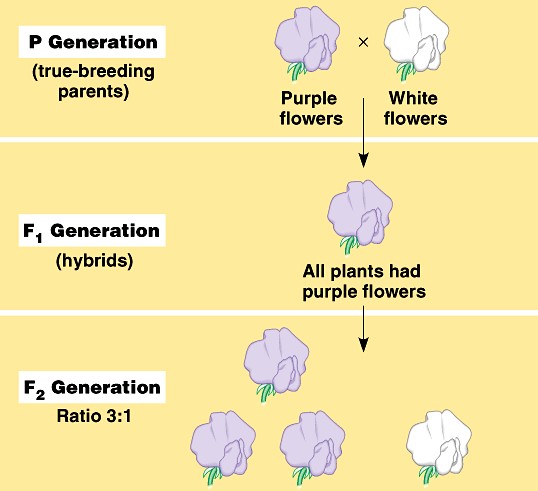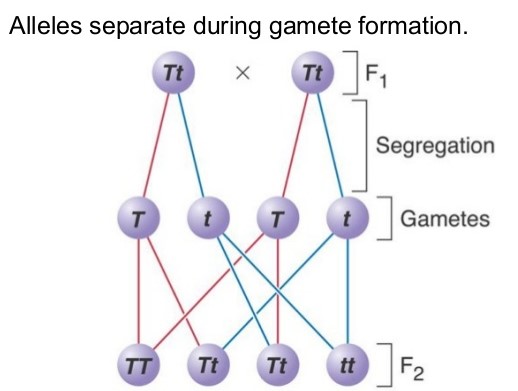
Based on the results obtained from the experiments on pea plant with contrasting characteristics for 8 continuous years, Gregor Johann Mendel formulated the three basic and fundamental laws of inheritance which are nowadays widely accepted throughout the world. Mendel formulated the following laws.
- Law of dominance
- Law of segregation/separation or the law of purity of gametes
- Law of independent assortment
Law of dominance:
The law of dominance states that “In a cross between a pair of organisms with pure contrasting characteristics, only the dominant of the pair expresses itself phenotypically while the other remains hidden in the F1 generation”.

In the above given chart, when a cross is made between two homozygous parents with purple and white colored flowers, the first generation (F1 generation) shows only the purple colored flowers as purple color is dominant over the white color.
In the F2 generation, the phenotypic ratio of dominant to recessive character (i.e. purple : white) is 3:1.
Law of segregation:
The law of segregation states that “When a pair of contrasting characteristics (alleles) is brought in a heterozygous individual (hybrid), the alleles of the contrasting pair stay together without mixing together for a long period of time but separate or segregate from each other during gamete formation. The gametes thus formed receive either of the alleles but not both and hence are pure”. This law is also called the law of purity of gametes.

In the above given chart, Tt (hybrid tall) is the plant obtained in the F1 generation. ’T’ and‘t’ remain together in that hybrid and only separate during gamete formation. As a result, two pure gametes with ‘t’ and ‘T’ but not both are formed.
Law of independent assortment:
The law of independent assortment states that “In a dihybrid cross (considering two or more pairs of unit characteristics at a time), the inheritance of each pair of unit character is independent of the other”.

In the above given chart, a dihybird cross is made between homozygous round-yellow and wrinkled-green seeds of pea plants and the F2 generation phenotype include 9 dominant yellow-round (YR) seeds, and 1 recessive green-wrinkled (yr). Two new combinations appeared of which 3 were green-round (Ry) and 3 yellow-wrinkled (Yr). Thus, the phenotypic ratio of 9:3:3:1 is obtained in the F2 generation.
Considering one pair of contrasting characters, there are 9+3=12 yellow to 3+1=4 green and 9+3=12 round and 3+1=4 wrinkled individuals. Thus, the ratio of 3 dominant to 1 recessive in each case follows Mendel’s law of dominance, as in a monohybrid cross. Thus, in a dihybrid cross, each pair of character is inherited independently of the other as found out by Mendel.